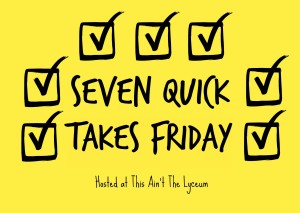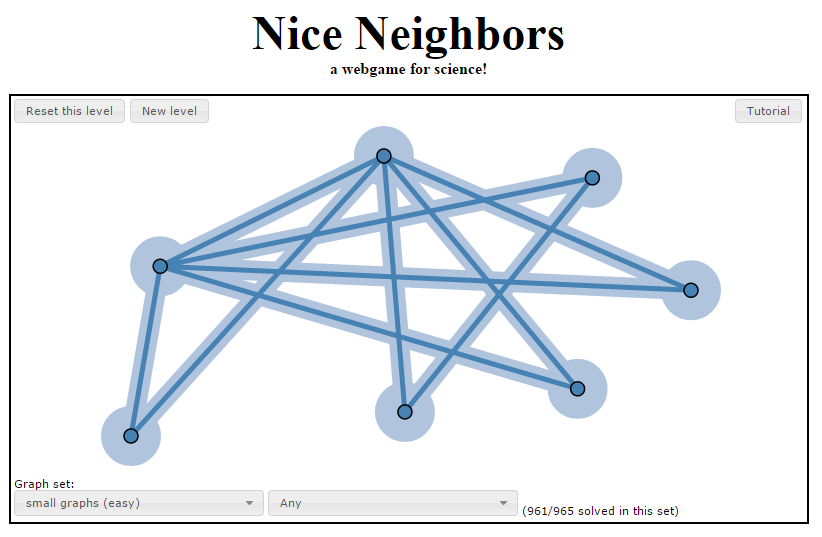Just a reminder, my new radio show (“Fights in Good Faith”) began last week (and the first episode is now up for streaming). Tune in live this week at 5p Saturday or 1p on Sunday. I’ll be talking about my visit to the National Civil Rights Museum in Memphis.
It’s hard to get more Leah-baity than a competition for math puns, so that link naturally gets first billing this week. Here’s my favorite:
Heard this joke about the Banach-Tarski paradox. I was beside myself! (@icecolbeveridge)
But the winner is probably a little more accessible:
My improper fractions helpline is now open 24/7. (@debecca)
There are a bunch more to delight you at the link.
In the slightly more useful realm of math links, the Nice Neighbors game is a crowdsourced proof. You play a webgame (about rearranging nodes and edges) and wind up helping expand our understanding of topology (by brute force) in the process:
The results in the paper (in particular Lemma 2.9) show that determining reducibility of a given digital image is equivalent to winning the game on this page.
Each “experimental level” in the game with at least 8 points represents a specific digital image whose reducibility is not known. If you can win on these levels, you are assisting in the effort to classify digital images by their reducibility. Thanks! Your solution will be saved and used in future research projects.
There’s a playable tutorial at the link, if you want to give it a try.
Also in the realm of applied math, and still involving crowds, seismologists are using their instruments to keep track of the ruckus raised by headbrick spectators. Here’s the best part:
But on Saturday, at least, football will be the focus, with a kind of technological race as well, since feedback from the stadium monitors — running about two or three seconds off real time — will be faster than the televised game, which will be broadcast with roughly a 10-second delay.
What that means is that seismically inclined fans who have QuickShake and the game on at the same time could get a kind of early warning of their own: the squiggle lines visible on the website will be tracking events in the stadium that have, in TV time anyway, yet to be shown.
And in one more link of scientists taking an interesting approach to group dynamics and actions, the NYT has an interesting obit this week for David H. Marlowe, who worked as an anthropologist for the army.
One of his early studies, of Army deserters in the 1950s, found that those who go AWOL are neither criminals nor cowards but mostly young people who cannot adapt to rigid military life. The poorest among them, he said, often have the hardest time adjusting, because of the social disorganization of their families and neighborhoods.
Dr. Marlowe argued that by pulling back on disciplinary actions — for minor offenses like uniform violations — the Army could retain more people and improve morale. Over time, the service has done just that, steeply reducing the number of its disciplinary barracks.
In another research project, investigating drug use among soldiers in the 1970s, Dr. Marlowe found that a crucial factor was group cohesion — measured by how well individuals formed bonds with the other members of their unit and how well their leaders knew them personally. In units where turnover was high and soldiers were virtual strangers, the use of heroin and other drugs tended to be heavy; in those where troops had some shared history, drug use was much less likely to be a problem.
After those studies, and based on his recommendation, the Army leadership made administrative changes to keep soldiers together longer, having them train together and move as units, according to Dr. Harry Holloway, a professor of neuroscience at the Uniformed Services University of the Health Sciences in Bethesda, Md., who was, for many years, Dr. Marlowe’s boss at the Walter Reed research institute.
This reminds me of some of observations that Jonathan Shay made in Achilles in Vietnam about the disorienting effect of staggered deployment rotations, which broke up unit cohesion, and the absence of long, united boat rides back to America (as opposed to flights) which troops used to transition out of the battlefield together in WWII.
Achilles in Vietnam turned out to be a really good book that I delayed reading for a while because the title seemed so enamored with itself. If you’ve been in danger of missing good books due to title choice or cover design (I didn’t read A Wrinkle in Time for a while since I was so scared of the Man with the Red Eyes on the cover. So scared that I hid the book behind the bookshelf), then perhaps you’ll enjoy this post from The Millions contrasting American and British cover design for some recent bestsellers.
This was the one where I thought it looked most like completely different genres of books.
Sticking on the theme of design choices, particularly ones that invite you to enter a new world, Two Strip Technicolor has a beautiful roundup of old-school special effects techniques. I remember reading about a couple of these in Muse Magazine (strongly recommended if you have kids in the 10+ range), but there are a bunch I’d never seen before, all illustrated so you can see how they work.
Finally, looking forward to the future of created environments, scifi author Charles Stross has a fascinating writeup of his trip to Tropical Islands, Germany — a massive, manufactured environment built inside a former aircraft hangar. He thinks it offers a preview of what our orbital environments would look like:
If someone goes nuts and tries to blow a hole in the wall of the fourth largest building in the world, well, there are evacuation routes into the car park. The failure modes for space colonies are much deadlier, so the panopticon paradise with tracking devices and cameras everywhere seems to be pretty much an inevitable corollary of such an environment. So, too, are climate control and the curation of space. The Aerium is cunningly filled with distractions and diversions, until the 5km rainforest walk seems unexceptional, even though it’s folded into a space less than 300 metres long: it’s as twisted and knotty as your intestines. Long-duration orbital colonists will need a sense of space: many of the same techniques—lots of interrupted sight lines, branching routes and creative environmental features—will almost inevitably be deployed. Everyone’s going to be under surveillance the whole time, behaviour monitored for signs of stress. Any children are going to be shepherded, lovingly but firmly, away from harmful things like airlock doors and plumbing, protected by doors that refuse to open for the unauthorized and robots that offer alternative, more attractive diversions for the fractious and bored or merely curious.
For more Quick Takes, visit Conversion Diary!















